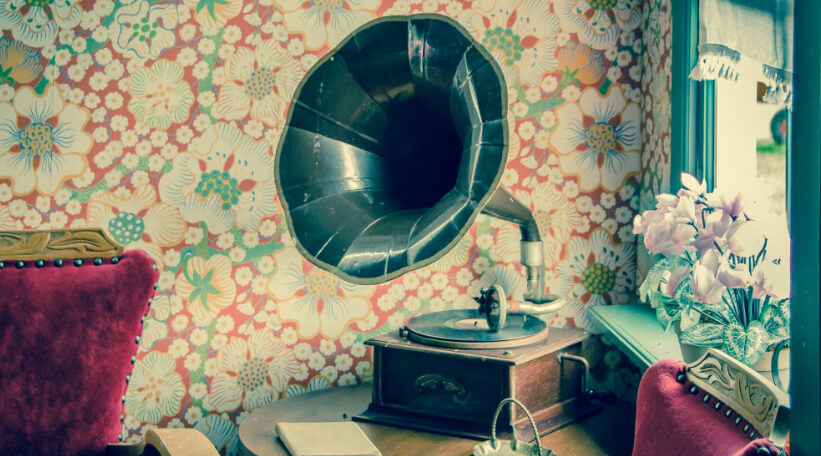Send your home back to a simpler time by incorporating vintage décor into your surroundings.
By Diane Franklin
Today, perhaps more than ever, many homeowners are feeling nostalgic for the days of yore. Incorporating vintage décor into your home is a way to indulge that desire to step back in time. If you’re inexperienced with the vintage décor style, here are some tips for how to do it right.
Create the Right Backdrop
Consider the walls of your room as the backdrop for vintage décor. The best paint color choices are typically whites, off-whites, warm neutrals and “whisper” pastels. Let the room help you decide what paint color your choose. For instance, a formal dining room may look best with a soft gray or taupe, whereas a romantic bedroom could show off its best advantages with walls in delicate pink or lavender.
Another excellent backdrop choice is vintage wallpaper, which in and of itself is a decorating element that can evoke another era. Traditional florals, elegant stripes, classic damask, sleek Art Deco and whimsical novelty patterns could all be appropriate choices. If you’re uncertain about committing to a particular wall décor, consider going with peel-and-stick wallpaper that is easy to put up and even easier to remove.
Adorn Windows and Floors
Window and floor coverings also contribute to the overall vintage décor look you are trying to achieve. At the window, some of your best choices might be 2-inch horizontal blinds, Roman shades or woven woods since each of these would fit in well with a bygone era. Lightweight and airy drapery fabrics in white or pale colors also can contribute to your overall vintage décor ambiance.
Among the best choices for flooring are hardwood floors, perhaps warmed up with a vintage-style area rug. Distressed rugs, with colors purposely faded to show a bit of age, are a perfect complement to your vintage décor. Washed-out blues, reds, oranges, greens and yellows are particularly effective in patterns ranging from florals to geometrics.
Seek Out Furnishings
The main venture of the vintage décor style are old furnishings, such as tables, chairs, dressers and armoires that either originate from—or evoke—a bygone era.
While there is no hard-and-fast definition about what era of furniture constitutes “vintage,” the consensus among experts is that the piece should be at least 20 or 30 years old but probably less than 100. If a piece goes back more than a generation or two, it more accurately could be called an antique.
Some consumers prefer a vintage look that focuses on a specific era—mid-century modern, for example—while others might opt to create an eclectic look that combines different pieces from various eras, such as the 1940s, 1960s and 1980s. The unifying element, in this case, can be color or recurring materials, such as wood or metal.
If you’re lucky, you’ll have family treasures that have been passed along to you from your parents or grandparents. Or perhaps you’ve acquired some unique furniture pieces by wandering through antique shops or making regular treks to garage sales and estate sales. There are also brick-and-mortar furniture sellers, as well as those online, that sell pieces that while technically new still have the distressed appearance of a vintage era.
Accessories from past generations also work well in vintage décor—such pieces as old steamer trunks, porcelain wash basins and pop culture memorabilia like Coca Cola merchandise, gas station signs, and classic toys. Some of these older accessories can be repurposed to better suit your décor. For instance, an old wooden toolbox or washtub can be turned into a planter. Another idea: You can take an oversized piece like an old headboard or door and turn it into a unique wall hanging.
In an ideal world, all of your older furnishings and accessories will have become distressed naturally in a way that is pleasing to the eye. But you can “help” the pieces along to fit better into your vintage décor setting. As an example, you can use a little sandpaper to make a porcelain wash basin look more aged and worn. Or you can restain a scuffed-up old storage trunk in a dark and vibrant wood tone that is more complementary to your room’s color scheme.
Keep in mind that vintage-looking pieces don’t technically have to be old. If you want to distress a new piece, such as an end table or picture frame, to give it an older appearance that fits into your décor, there are absolutely no rules against it. All is fair when it comes to your love of vintage decorating—and creating just the right look for your home.

 Interior Paints
Interior Paints Exterior Paints
Exterior Paints Primers
Primers Stains & Clears
Stains & Clears
 Paint Brushes
Paint Brushes Paint Roller
Paint Roller Paint Trays & Liners
Paint Trays & Liners



